Themed collection Nanoscience and nanotechnology in electrochemistry

Mesoporous carbons: recent advances in synthesis and typical applications
Mesoporous carbon materials have been extensively studied because of their vast potential applications ranging from separation and adsorption, catalysis, and electrochemistry to energy storage.

RSC Adv., 2015,5, 83239-83285
https://doi.org/10.1039/C5RA16864C
Electrolytic manganese dioxide (EMD): a perspective on worldwide production, reserves and its role in electrochemistry
EMD – a weird but played wonderful role in electrochemistry and its intercalation mechanism suitable for alkaline rechargeable batteries and supercapacitors.
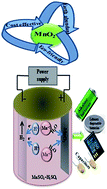
RSC Adv., 2015,5, 58255-58283
https://doi.org/10.1039/C5RA05892A
Recent advances in porous graphene materials for supercapacitor applications
This paper reviews the recent developments in the synthesis and applications of porous graphene materials for supercapacitors.
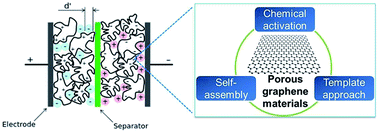
RSC Adv., 2014,4, 45862-45884
https://doi.org/10.1039/C4RA07869A
Nanoalloy catalysts for electrochemical energy conversion and storage reactions
A key challenge to the exploration of electrochemical energy conversion and storage is the ability to engineer the catalyst in terms of composition, morphology, and structure towards low cost, high activity and high stability.
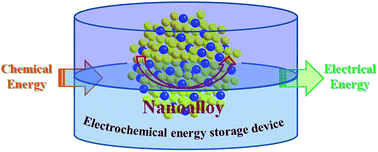
RSC Adv., 2014,4, 42654-42669
https://doi.org/10.1039/C4RA05943C
Recent advances in Mn-based oxides as anode materials for lithium ion batteries
The Mn-based oxides including MnO, Mn3O4, Mn2O3, MnO2, CoMn2O4, ZnMn2O4 and their carbonaceous composite/oxide supports with different morphologies and compositions as anode materials are reviewed.
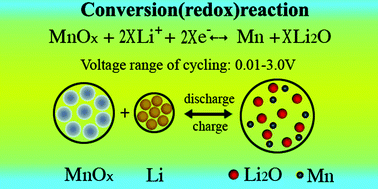
RSC Adv., 2014,4, 23914-23935
https://doi.org/10.1039/C4RA02686A
A new strategy for detecting dopamine in human serum using polymer brushes reinforced with carbon nanotubes
Schematic of dopamine detection in blood serum in presence of ascorbic acid and uric acid using polymer brushes reinforced with MWNTs.
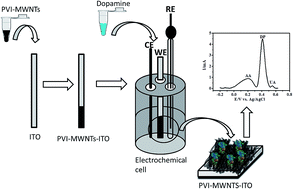
RSC Adv., 2016,6, 47134-47137
https://doi.org/10.1039/C6RA05151K
Dispersing Pt and Pd atoms on Au nanoparticles deposited on n-GaN substrates for formic acid oxidation
Au nanoparticles, with dispersed Pt and Pd atoms on them, supported on n-GaN substrates were prepared. The catalysts showed an enhanced performance for formic acid oxidation, and the mass activity reached 3.5 mA μgPtPd−1.
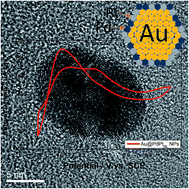
RSC Adv., 2015,5, 92757-92761
https://doi.org/10.1039/C5RA16807D
Electrochemistry of actinides on reduced graphene oxide: craving for the simultaneous voltammetric determination of uranium and plutonium in nuclear fuel
Schematic representation of the interference of Pu(IV) in the voltammetric determination of U in a mixed U–Pu solution in 1 M H2SO4.

RSC Adv., 2015,5, 59437-59446
https://doi.org/10.1039/C5RA09892K
The influence of nanoparticles on enzymatic bioelectrocatalysis
Detailed experimental evidences that neither an overpotential of bioelectrocatalysis, nor direct electron transfer and bioelectrocatalytic reaction rates for an adsorbed enzyme depend on the size of gold nanoparticles, are presented.
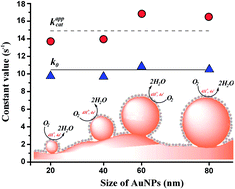
RSC Adv., 2014,4, 38164-38168
https://doi.org/10.1039/C4RA08107B
Non-enzymatic simultaneous detection of L-glutamic acid and uric acid using mesoporous Co3O4 nanosheets
Co3O4 nanosheets were synthesized by wet chemical technique at low-temperature in alkaline phase.
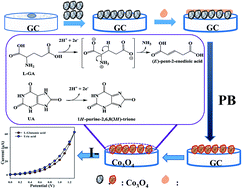
RSC Adv., 2016,6, 80511-80521
https://doi.org/10.1039/C6RA12256F
An atomically thick titanium phosphate thin layer with enhancing electrochemical sensitivity toward Pb(II)
An atomically thick titanium phosphate thin layer is synthesized and used for sensitive electrochemical detection for Pb(II) with a high sensitivity and low limit of detection.
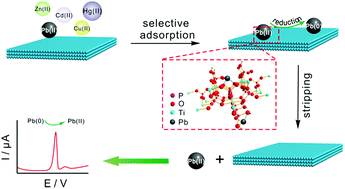
RSC Adv., 2016,6, 72975-72984
https://doi.org/10.1039/C6RA08679A
Photoelectrochemical detection performance and mechanism discussion of Bi2O3 modified TiO2 nanotube arrays
Bi2O3 were deposited on anodized TiO2 nanotube arrays by chemical bath deposition combined with calcination.
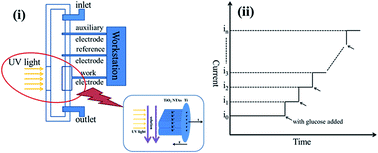
RSC Adv., 2016,6, 61367-61377
https://doi.org/10.1039/C6RA11074F
A simple regenerable electrochemical aptasensor for the parallel and continuous detection of biomarkers
In this present work, a simple regenerable electrochemical aptasensor for the parallel and continuous detection of protein biomarkers is reported.
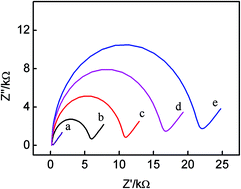
RSC Adv., 2016,6, 58469-58476
https://doi.org/10.1039/C6RA09284E
Highly poison-resistant Pt nanocrystals on 3D graphene toward efficient methanol oxidation
Highly poison-resistant Pt nanocrystals are synthesized using reductive sugars derived from pectin hydrolysis, showing efficient catalytic performance toward methanol oxidation.
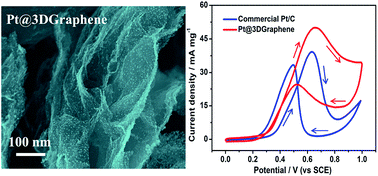
RSC Adv., 2016,6, 50726-50731
https://doi.org/10.1039/C6RA06517A
Detailed investigation of a NaTi2(PO4)3 anode prepared by pyro-synthesis for Na-ion batteries
NaTi2(PO4)3 nanoparticles are synthesized by a facile polyol-assisted pyro-synthetic reaction.
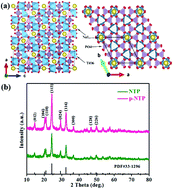
RSC Adv., 2016,6, 45605-45611
https://doi.org/10.1039/C6RA06533C
Fabrication of a heated electrode modified with a thiol-functionalized ionic liquid for electrochemical/electrochemiluminescence sensors
A new heated thiol-functionalized ionic liquid (TFIL)/Au composite electrode, which possessed the advantages of a heated electrode technique and ionic liquids (ILs), was designed and fabricated in this study.
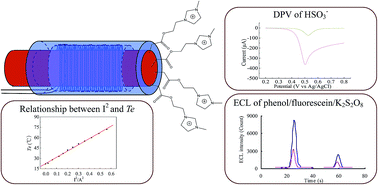
RSC Adv., 2016,6, 39955-39961
https://doi.org/10.1039/C6RA05302E
The effect of barium sulfate-doped lead oxide as a positive active material on the performance of lead acid batteries
Barium sulfate (BaSO4) is a common impurity in recycled lead paste, and the effect of this impurity in positive active materials on the performance of recycled lead acid batteries was investigated.

RSC Adv., 2016,6, 27205-27212
https://doi.org/10.1039/C6RA01873D
A promising anode material for sodium-ion battery with high capacity and high diffusion ability: graphyne and graphdiyne
First-principles calculations indicate that a novel atomic hollow structure of graphyne and graphdiyne made up of sp- and sp2-hybridized carbon atoms reinforces not only the Na storage capacity but also the Na diffusion.

RSC Adv., 2016,6, 25594-25600
https://doi.org/10.1039/C6RA01870J
High impact of the reducing agent on palladium nanomaterials: new insights from X-ray photoelectron spectroscopy and oxygen reduction reaction
The nature of the reduction agent changes drastically the palladium nanomaterials chemical stability, which subsequently alters earnestly their catalytic performances.
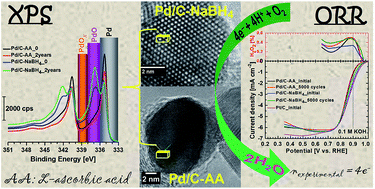
RSC Adv., 2016,6, 12627-12637
https://doi.org/10.1039/C5RA24829A
Exploration of the electrochemical mechanism of ultrasmall multiple phases molybdenum carbides nanocrystals for hydrogen evolution reaction
Ultrasmall multiple phases molybdenum carbides nanocrystals (down to 2.5 nm) on graphene support were synthesized by a simple in situ method. These hybrids show extraordinary high HER activity in acid media.
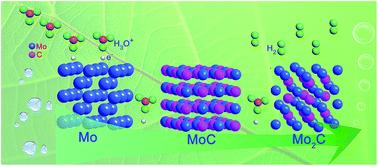
RSC Adv., 2016,6, 9240-9246
https://doi.org/10.1039/C5RA25367E
A recast Nafion/graphene oxide composite membrane for advanced vanadium redox flow batteries
GO nanosheets in Nafion effectively block the crossover of vanadium ions while hydrogen bonds between GO and Nafion increase the mechanical stability, significantly improving the efficiency and cyclability in a rNafion/GO membrane based VRFB.
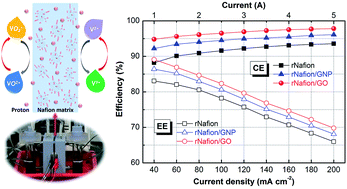
RSC Adv., 2016,6, 3756-3763
https://doi.org/10.1039/C5RA24317C
Electrochemical Ostwald ripening and surface diffusion in the galvanic displacement reaction: control over particle growth
We could control the particle growth in the galvanic displacement reaction on amorphous Ge substrate by introducing reduced electron mobility and surface defects over crystalline Ge, where electrochemical Ostwald ripening has been observed.
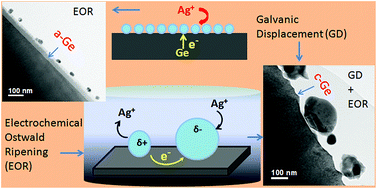
RSC Adv., 2015,5, 94380-94387
https://doi.org/10.1039/C5RA20297C
Controlled electrodeposition of nanostructured Pd thin films from protic ionic liquids for electrocatalytic oxygen reduction reactions
Nanostructured Pd thin films are prepared from protic ionic liquids via hydrogen-assisted electrodeposition for oxygen reduction reactions.
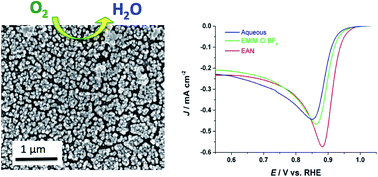
RSC Adv., 2015,5, 74017-74023
https://doi.org/10.1039/C5RA13898A
Insight into the limited electrochemical activity of NaVP2O7
Recently, LiVP2O7 has been investigated as a possible high-voltage substitute for Li2FeP2O7.
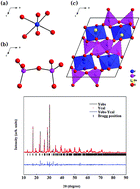
RSC Adv., 2015,5, 64991-64996
https://doi.org/10.1039/C5RA12158B
Chemical and electrochemical hydrogenation of CO2 to hydrocarbons on Cu single crystal surfaces: insights into the mechanism and selectivity from DFT calculations
The research results have great significance for the in depth understanding of the selectivity of the CO2 electrochemical reduction process and the sensitivity of the Cu surface structure.
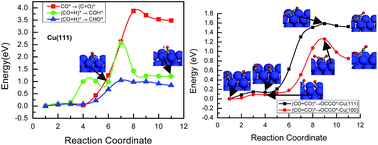
RSC Adv., 2015,5, 57361-57371
https://doi.org/10.1039/C5RA09294A
Improving the electrochemical performance of a lithium–sulfur battery with a conductive polymer-coated sulfur cathode
A pristine sulfur electrode with simple PEDOT:PSS coating achieves significant enhancement in both sulfur utilization and capacity retention.

RSC Adv., 2015,5, 44160-44164
https://doi.org/10.1039/C5RA05481H
In situ electrochemical characterisation of graphene and various carbon-based electrode materials: an internal standard approach
An internal standard protocol is utilised to simultaneously characterise and utilise carbon-based electrode materials during their implementation.
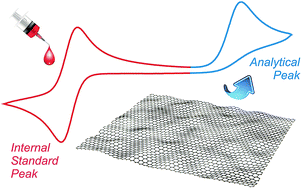
RSC Adv., 2015,5, 37281-37286
https://doi.org/10.1039/C5RA03049H
A high rate Li-rich layered MNC cathode material for lithium-ion batteries
Morphology-driven Li1.2Mn0.6Ni0.14Co0.06O2 with excellent cycling stability.
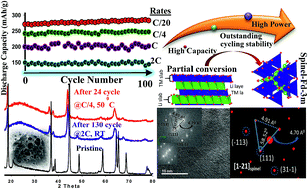
RSC Adv., 2015,5, 27375-27386
https://doi.org/10.1039/C4RA17235C
Insight into luminescent bisazoaromatic CNN pincer palladacycle: synthesis, structure, electrochemistry and some catalytic applications in C–C coupling
The 2-(phenylazo)azobenzene furnished novel palladacycles in excellent yield, which showed luminescence at rt and catalytic activity. The optoelectronic and electrochemical responses were substantiated with DFT and TDDFT.
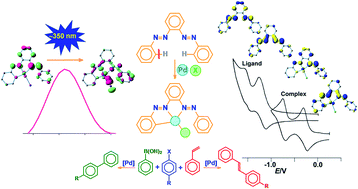
RSC Adv., 2015,5, 22544-22559
https://doi.org/10.1039/C4RA16584E
Metal–organic framework-derived nickel phosphides as efficient electrocatalysts toward sustainable hydrogen generation from water splitting
Ni-based metal–organic framework (MOF)-derived Ni2P nanoparticles exhibited high-performance for electrochemical HER, as manifested by a low overpotential and a large cathodic current density.
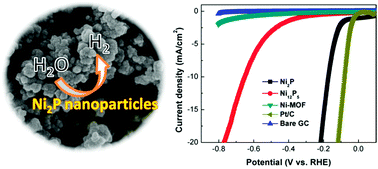
RSC Adv., 2015,5, 10290-10295
https://doi.org/10.1039/C4RA15680C
Cobalt phthalocyanine tetracarboxylic acid modified reduced graphene oxide: a sensitive matrix for the electrocatalytic detection of peroxynitrite and hydrogen peroxide
The electrocatalytic properties of cobalt phthalocyanine modified reduced graphene oxide for peroxynitrite and hydrogen peroxide are investigated.
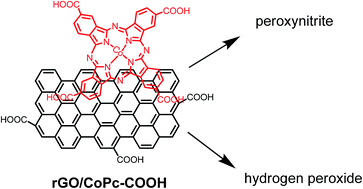
RSC Adv., 2015,5, 1474-1484
https://doi.org/10.1039/C4RA09781E
Retracted Article: Multi-walled carbon nanotubes decorated with palladium nanoparticles as a novel platform for electrocatalytic sensing applications
Sensitive detection of glucose using a glassy carbon electrode modified with glucose oxidase and multi-walled carbon nanotubes decorated with palladium nanoparticles.
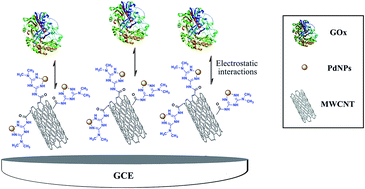
RSC Adv., 2014,4, 49595-49604
https://doi.org/10.1039/C4RA08536A
High-performance hybrid perovskite solar cells with polythiophene as hole-transporting layer via electrochemical polymerization
Thin polythiophene film prepared via electrochemical polymerization has been successfully used as the hole-transporting layer in CH3NH3PbI3 perovskite solar cells, affording a series of ITO/polythiophene/CH3NH3PbI3/C60/BCP/Ag devices.
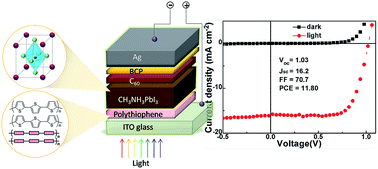
RSC Adv., 2014,4, 33039-33046
https://doi.org/10.1039/C4RA05578K
Fundamental electrochemistry of three-dimensional graphene aerogels
The graphene aerogel we prepared contains an interconnected porous structure, and it exhibits the best electrochemical performance when thermal reduced at 250 °C.
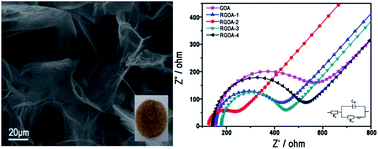
RSC Adv., 2014,4, 30689-30696
https://doi.org/10.1039/C4RA04088K
Structural electrochemistry. Chronopotentiometric responses from rising compacted polypyrrole electrodes: experiments and model
A model considering conformational packing and structural relaxation–swelling effects describes and quantifies chronopotentiometric responses from conducting polymer film electrodes.
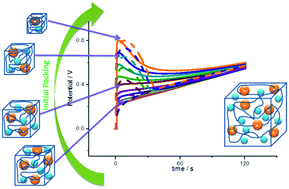
RSC Adv., 2014,4, 29139-29145
https://doi.org/10.1039/C4RA04530K
Direct electrochemistry of cytochrome c immobilized on a graphene oxide–carbon nanotube composite for picomolar detection of hydrogen peroxide
A new bionanocomposite electrode based on cytochrome c immobilized graphene oxide-multiwalled carbon nanotube is used to fabricate a highly selective and sensitive amperometric biosensor for the picomolar level detection of hydrogen peroxide which may find application in bioimaging and healthcare
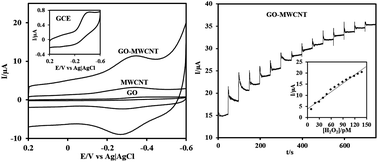
RSC Adv., 2014,4, 28229-28237
https://doi.org/10.1039/C4RA02789B
Surface morphology and corresponding electrochemistry of polypyrrole films electrodeposited using a water miscible ionic liquid
Polypyrrole layers were deposited on polycrystalline gold from solutions of pyrrole in the ionic liquid 1-butyl-3-methylimidazolium tetrafluoroborate and its equimolar mixture with water by using potential controlled electrochemical methods.
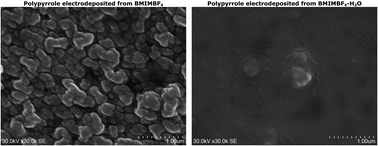
RSC Adv., 2014,4, 22214-22223
https://doi.org/10.1039/C4RA03497J
Effect of carbon type on the performance of a direct or hybrid carbon solid oxide fuel cell
The impact of carbon type on DCFC performance is explored; the optimum performance is obtained with biomass-derived pine charcoal.
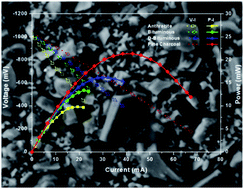
RSC Adv., 2014,4, 18792-18800
https://doi.org/10.1039/C4RA01022A
Impact of alloying and lattice strain on ORR activity of Pt and Pd based ternary alloys with Fe and Co for proton exchange membrane fuel cell applications
A novel structure–catalytic activity correlation of platinum and palladium alloys is reported in this study.
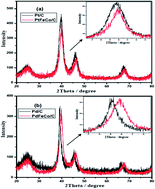
RSC Adv., 2014,4, 11939-11947
https://doi.org/10.1039/C3RA47021K
Electrode architectures for high capacity multivalent conversion compounds: iron (II and III) fluoride
Using carbon fiber based architecture we demonstrate multi-electron capacity and lower voltage hysteresis from iron fluoride based conversion electrodes.
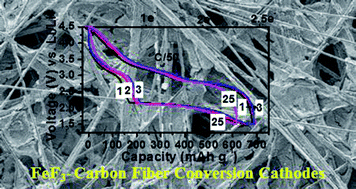
RSC Adv., 2014,4, 6730-6737
https://doi.org/10.1039/C3RA47266C
Shape controlled synthesis of CeO2 nanostructures for high performance supercapacitor electrodes
We report CeO2 nanostructures with the desired shape synthesized via a simple hydrothermal approach without any specific structure directing agent for supercapacitor applications.
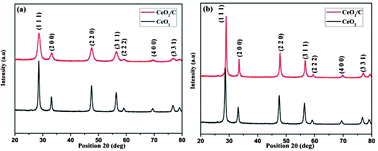
RSC Adv., 2014,4, 6527-6534
https://doi.org/10.1039/C3RA43339K
Controlled chemistry of tailored graphene nanoribbons for electrochemistry: a rational approach to optimizing molecule detection
Electrochemical detection of target molecules on tailored graphene nanoribbons.
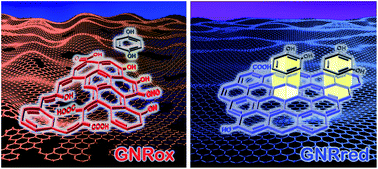
RSC Adv., 2014,4, 132-139
https://doi.org/10.1039/C3RA44235G
About this collection
Welcome to this themed collection ‘Nanoscience and Nanotechnology in Electrochemistry,’ Guest Edited by Professor Chang Ming Li (Southwest University, Chian). The articles presented here cover many aspects of nanoscience and nanotechnology in electrochemistry with fundamental theories and practical applications. These particular research and review articles span a range of various synthetic methods for unique and superior nanomaterials and their functional behaviours, which result from host/guest chemistry, as well as some scientific structural insights. In particular, important electrochemical applications are vividly displayed in electrochemical energy conversion/storage systems such as batteries, supercapacitors, solar energies, hydrogen production, and electrochemical sensors. This collection of articles greatly illustrates the beauty, diversity and increasing importance of nanoscience and nanotechnology in electrochemistry. I hope you enjoy reading it.